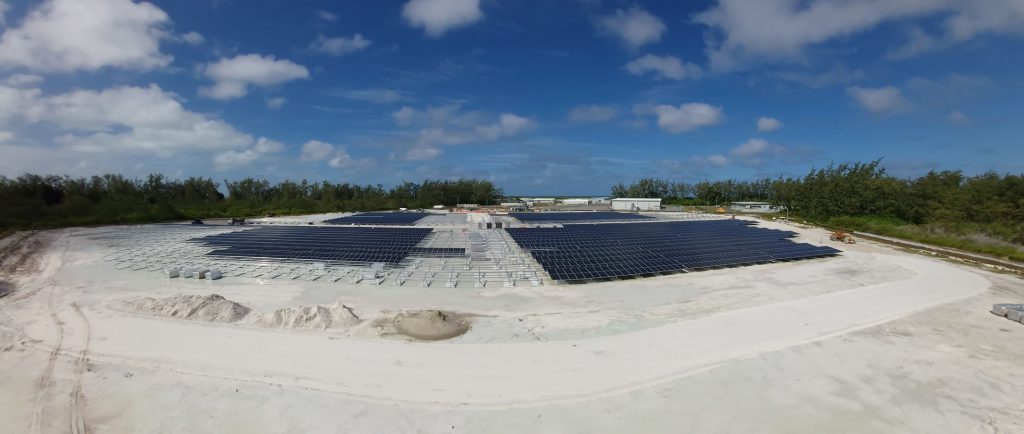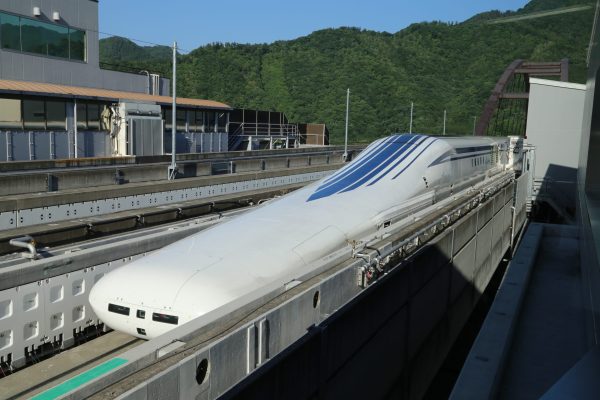By Edie Evans, P.E., CEM, M.SAME, Elbert Hwang, and Grant Nakata
Through the issuance of recent Executive Orders, the White House has reiterated the importance of energy resilience and reinforced that climate change is a national security threat. The federal government is positioned to provide leadership in energy management and energy security and resilience, using advanced and distributed energy technologies.
The U.S. Navy’s energy security focus leverages clean, reliable energy to meet our mission needs by closely following program priorities driven by Executive Orders, updated policy and guidance, and legislative changes in the National Defense Authorization Act. Current actions to meet energy security across the enterprise consist of deploying cybersecure microgrids with battery storage capabilities, conducting energy resilience and black start exercises, and leveraging third-party financing to accelerate the uptake of energy, water, and resiliency measures.

on 13-acres of undeveloped land. NAVFAC PACIFIC PHOTOS
STRATEGICALLY ALIGNED
The U.S. Navy has established three pillars of its Energy Security Framework: reliability, resiliency, and efficiency.
Reliability is measured by the frequency and duration of service disruptions to customers and the magnitude of the adverse effects. Resiliency is the ability to improvise, adapt, and overcome anticipated and unanticipated energy disruptions in order to provide mission assurance. Efficiency is the minimum energy use required to achieve the desired level of service to meet mission requirements.
Delivering reliability means increasing the capability of an installation to prevent and resist a utility disruption regardless of the cause, whether environmental or adversarial. Enhancing reliability through installation energy plans is a priority across the Department of Defense. We must ensure our warfighters can access energy and water resources whenever needed—whether day-to-day operations, during conflict, or in emergency scenarios. The importance of energy and water security increases as climate change brings new and more frequent environmental stressors to our installations.
With an emphasis on climate and net zero emissions, we remind our energy managers to optimize building performance for efficiency first.
Our installation energy plans are aligned to the Chief of Naval Operations Navigation Plan 2022: Get Real, Get Better. The Navy was the first defense agency to complete all Installation Energy Program Summaries (IEPS), which provide the framework to assess installation energy progress across the Navy Shore Energy Program. An IEPS identifies energy security, cybersecurity, physical security, climate change, network, and contingency operation vulnerability gaps for critical missions, such as poor power quality or lack of backup power at critical facilities. Each region then prioritizes investments to close the gaps.
The Energy Project Selection Process generates a list of critical infrastructure projects, focusing the Navy’s limited budget on the highest mission priorities. Operations and maintenance requirements for energy security projects also must be included for lifecycle cost.
LEVERAGING FINANCING
Issued in December 2021, Executive Order 14057, Catalyzing Clean Energy Industries and Jobs Through Federal Sustainability, requires the Navy to collaborate with utility providers to achieve 100 percent carbon pollution-free electricity by 2030. Already the Navy successfully utilizes enhanced use leases to leverage public-private partnerships that value underutilized defense real estate for in-kind consideration.
An example of this approach, to use third-party financing to pay for critical infrastructure improvements, can be found at the Pacific Missile Range Facility, Barking Sands, Hawaii, where an enhanced use lease was used to install 19.3-MW of solar photovoltaics with a 70-MWh battery energy storage system and new 20-MVA substation. As part of the in-kind consideration, the local utility KIUC constructed energy resilience infrastructure improvements in response to potential power grid disruptions.
The project was tested and commissioned in June 2022 and demonstrated the ability to microgrid the solar photovoltaics and battery storage plant under three scenarios: a planned microgrid; a black start event; and a transmission line outage. During the initial 12 months of operation, the system produced 27,674- MWh of solar power, displaced over 2.1-million-gal of petroleum fuel for electricity production, avoided more than 29,000-metric-T of carbon dioxide equivalent greenhouse gas, and provided $2.1 million in fuel cost savings for Kauai rate payers. This output aligned the project with the Hawaii Clean Energy Initiative to achieve 100 percent clean energy by 2045.

PRIORITIZING NEEDS
Naval readiness is threatened by the lack of mission continuity that occurs during power outages or cybersecurity attacks. The Navy is committed not only to investing in energy security but to testing critical infrastructure as well. Efforts are underway to hold energy resilience readiness “black start” exercises to identify mission assurance vulnerabilities. Testing the resilience, reliability, and efficiency of existing systems stresses the aging infrastructure and teaches us to anticipate and respond to failures.
Newer Navy contracts have a duration of 15 to 20 years and include operations and
maintenance. However, we are now pressing the 25-year limit on these contracts to include costly resiliency measures and control system cybersecurity.
The Navy is investing significantly in infrastructure improvements and recapitalization to replace critical equipment such as generators, transformers, switchgear, and control systems. Improvements provide back-up power through renewable systems, batteries, or other sources of generation to achieve resilient utility networks. The Navy must increase funding targeted at energy and water distribution, including budgets and staffing, to replace, modernize, and maintain the existing systems that enable fleet readiness, reduce vulnerabilities, and further build climate resilience and reduce climate threat.
A recently constructed, mission-enabling project at Diego Garcia, executed through the Energy Resilience and Conservation Investment Program, converted 13-acres of undeveloped land into a photovoltaic solar field that generates approximately 3-MW of AC power through 12,000 panels. For added reliability, a 500-kW battery energy storage was installed that uses lithium-ion batteries. The system will provide backup power to supplement the photovoltaic array during cloud cover, rain, or other climate changes that affect the solar plant output. The battery system is designed to discharge up to 1-MW of power in 30 minutes. Installation of new electrical energy infrastructure and fiber optic communications provides additional energy resiliency. The installed photovoltaic system will displace approximately 6,000-MWh per year of electricity that is currently generated from JP-5 fuel oil. The equivalent fuel oil reduction is 505,400-gal (62,800-million-BTU/year), representing an annual cost savings of $1.84 million.
The Energy Resilience and Conservation Investment Program has grown to comprise more than $1 billion in Navy projects at various stages of development across the Pacific area of operations alone. Projects are becoming more complex and more expensive, however. To adjust to this growth, the program is now aligned with MILCON and uses the same Shore Mission Integration Group process for prioritization and approval.
SOLUTIONS FOR RESOURCING
The National Defense Authorization Act for Fiscal Year 2021 enables projects to leverage appropriated funds with energy savings performance contracts (ESPCs) and utility energy services contracts (UESCs). Third-party financed projects comprehensively address site-wide energy, water, and resiliency measures. Combining funding through the Energy Resilience and Conservation Investment Program with ESPCs and UESCs makes projects more economically feasible and addresses the resourcing and staffing challenges of operating and maintaining more complex energy management systems.
The Navy plans to implement third-party financing to the maximum extent to accelerate energy efficiency, savings, and renewable energy to achieve $750 million in energy savings and investments to recapitalize energy-related infrastructure. ESPCs form partnerships between the Navy and an energy service company, which implement energy conservation measures for systems to run more efficiently. The energy service company also provides guaranteed annual energy savings. Newer Navy contracts have a duration of 15 to 20 years and include operations and maintenance. However, we are now pressing the 25-year limit on these contracts to include costly resiliency measures and control system cybersecurity.
Recently, Marine Corps Installation Command Pacific partnered with Naval Facilities Engineering Systems Command to execute a roughly $400 million ESPC in Japan. This is the largest ESPC project in the Pacific area of operations and will provide energy security and conservation measures at three Marine Corps installations: Camp Fuji, MCAS Iwakuni, and Camp Butler. Energy conservation measures will provide the installations guaranteed savings, including lighting retrofits, variable frequency drives, and control systems to optimize operations.
In addition to traditional energy conservation measures, the project is also strongly incorporating resiliency. While these still provide savings payback, the focus is to provide additional generation or backup power to support 14-day contingency requirements. Resiliency energy conservation measures may include natural gas peaker plants, microgrids, and additional backup power for essential facilities across the three installations.

ENSURING READINESS
Moving into the digital age, the Navy smart grid integrates advanced metering infrastructure, building control systems, and utility control systems at the Facility Energy Operation Center using OSI PI data analytics to optimize resources, reduce energy consumption, and maximize operational availability.
The smart grid serves to improve the energy security of critical assets and provides the advanced analytics to maximize naval readiness. The analytics inform leadership to drive facility and utility operational efficiencies.
Before connecting to a smart grid, however, the Navy is committing to standardizing installation facility-related control systems, which simplifies the risk management framework process for authority to operate. Once connected, the control system platform enclave allows continuous cybersecurity monitoring for control system sustainment.
As we move forward, the Navy shore enterprise will continue to prioritize and collaborate with utility service providers and industry partners to transition new technology that can effectively mitigate energy security vulnerabilities and provide operations and maintenance capabilities to support warfighter readiness.
More News from TME
-

Developing a Maglev Network for National Defense
A transportation network leveraging superconducting magnetic levitation technologies would bring benefits for logistics, surface transportation, and energy storage, as well as strengthen national defense priorities and the defense industrial base. -

Meeting Training Needs with a One-of-a-Kind Diving Facility
In the planning process of a new Expeditionary Maritime Operations Center at Joint Expeditionary Base Little Creek-Fort Story, close collaboration and careful design was necessary to provide a path forward for a substantially deep training pool and meet the needs of advanced diving teams and other maritime operators. -

Delivering Successful Projects for USACE Far East District
Establishing a physical presence in Korea and collaborating with local contractors can assist U.S.-based firms in successfully delivering federal projects on the peninsula.